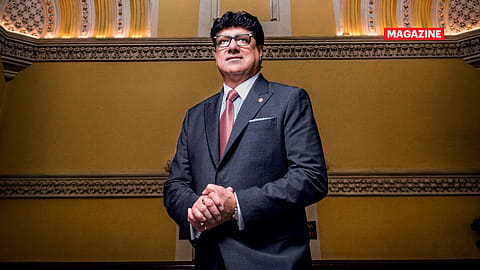India’s Best CEOs 2025: Puneet Chhatwal is Reinventing Legacy at IHCL
Winner-Hospitality: Revitalising Taj hotels to reshaping strategy — Puneet Chhatwal has turned IHCL into a hospitality powerhouse.

This story belongs to the Fortune India Magazine indias-best-ceos-november-2025 issue.
HAVING WORKED IN Germany for the greater part of his career, German comes naturally to Puneet Chhatwal, MD and CEO, Indian Hotels Company Ltd (IHCL). At his office in Mumbai, Chhatwal effortlessly comes up with at least half a dozen quotes in German. One of them being — ‘the one who doesn’t go with time goes with time’ (You have to keep reinventing and reimagining yourself with time to address the needs and wants without changing the core). When he took over the reins of the Tata group’s hospitality business in 2017, the mandate given to him was exactly that — reimagine and reinvent the legacy hotel chain.
However, his new role then was far from enviable. The company was loss-making and had debt of ₹3,159 crore on its books. Over 80% of its revenue came from Taj, but the flagship brand had lost its sheen over the years. The younger clientele had started leaning towards global ones such as Marriott, Radisson and Hilton. IHCL’s other brands — Vivanta (business hotels) and Ginger (focussed on the value segment) — were not going anywhere either.
Chhatwal saw immense opportunity nevertheless. “We were sitting on the best iconic assets and land parcels,” he says. Within a week of joining, he called a strategy meeting at Taj Fort Aguada in Goa, the beachfront resort overlooking the ramparts of the historic 16th-century Portuguese fort. The management spent two days to come up with the interim strategy ‘Project Win’. The idea was to register profit on the books. The senior management met in November 2017 and decided to ensure that the company made an Ebita (earnings before interest, taxes, and amortisation) of ₹100 crore at the end of FY18. Chhatwal and his team tried to optimise costs wherever they could. The company eventually ended up with a PAT of ₹101 crore the following year.
Barring hiccups during the pandemic when the company went into the red again, there has been no looking back. In fact, IHCL is almost debt-free. Revenue increased 23% YoY in FY25, while net profit grew 52%. Out of its portfolio of 570-plus hotels, including the ones in the pipeline, over 130 come under the Taj brand, which, according to Chhatwal, “is the backbone of the company’s transformation journey”.
Among his earliest moves was moving to a capital-light model. When Chhatwal joined IHCL, just 44% of its portfolio ran on management contracts. Today, the ratio is 50:50. The plan is to move to a 40:60 model. “If you are on a quick growth path, you can’t build on your own; for a better-hedged portfolio, you shouldn’t own everything. Asset-light models enable faster growth and more profitability. It gives you fee-based growth, which leads to margin expansion,” he explains.
Chhatwal doesn’t agree that Taj’s appeal has gone down for the younger generation. “That’s not correct. Taj has always been dil se and people have stayed with us for generations. We made a few bold moves (launching business hotel brand Vivanta and value brand Ginger) in the early 2000s and then the world changed upside down — there was the global financial crisis, and thereafter, the Taj Mahal Palace in Colaba fell victim to the 26/11 attack. That put us in a loss-making spiral from 2008-17.”
Between 2008 and 2017, when the company wasn’t making money, it downgraded several iconic properties, including the likes of Holiday Village (Goa), Fort Aguada (Goa) and Fisherman’s Cove (Mahabalipuram) to Vivanta. Though the decision made sense at that point in time because they didn’t see the required revenue contribution, Chhatwal felt the need to upgrade them back to the old glory. “These hotels together with the 20-30 hotels we signed immediately brought Taj to a 75-plus portfolio, and started performing… Today, Taj has a portfolio of over 130 (including the ones in the pipeline) hotels.”
More Stories from this Issue
After upgrading the Vivanta properties as Taj, the company re-imagined Vivanta as a premium business hotel brand. With Ginger, however, Chhatwal has moved to an ownership model. “For an asset-light model to work, you need a big scale. You need to scale to 200-300 hotels, which gives you a fee. An asset-light model gives you just 6-7% of top line and if your revenue size is small, it’s not viable,” he says. The company currently has 66 operational Ginger hotels.
Chhatwal’s journey of reinventing and reimagining IHCL continues. The company is entering new countries. Recently it has entered Germany with a Taj in Frankfurt. Switzerland is next. It is also taking its popular F&B brands, House of Ming and Bombay Brasserie, outside India.
Chhatwal’s ambition to scale IHCL to a ₹15,000-crore behemoth by 2030 is certainly on track.